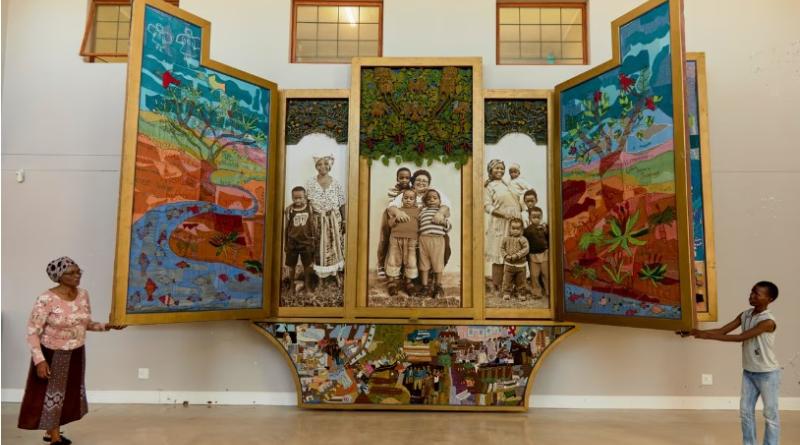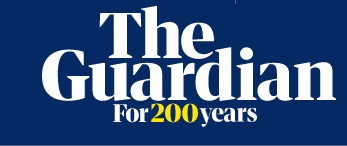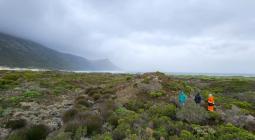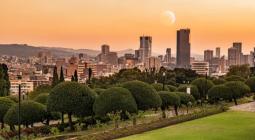‘Our tapestries open ears’: the South African women stitching monumental tales of love and loss

Standing at the foot of the giant hanging tapestry, Veronica Betani recalls the bitter period that is depicted in its colourful threads: mourning women watching over orphaned children, a hospital room filled with gaunt bodies, a burial.
“This is the funeral of Mama Susan Paliso’s son,” she sighs, staring at the work she embroidered with 130 other women. “It was very painful to make this piece, because this isn’t just any story: it is the story of people that we know, that we loved, of people that lost their loved ones.”
The Keiskamma Altarpiece, which incorporates embroidery, beadwork, wire sculpture and photographs, depicts the devastation of HIV and the community’s resilience in Hamburg, a tiny town at the end of a dirt road on the lush banks of the Keiskamma River, in South Africa’s Eastern Cape province. It was made by the women of a rural collective that, for more than 20 years, has crafted monumental artworks depicting global issues.
The Keiskamma Trust was founded in 2000 by the doctor and artist Carol Hofmeyr to foster dignity in a community ravaged by HIV. Today, it encompasses health and education programmes, along with a music academy, which have become cornerstones of the region, but it’s the embroidery work that has garnered most acclaim.
“Our tapestries open ears,” says Betani proudly. The altarpiece was exhibited in Toronto for the 2006 international Aids conference. The women’s first masterpiece, the 120-metre (394ft) Keiskamma Tapestry (inspired by the Bayeux tapestry), depicting South Africa’s colonial history, was on permanent display in the nation’s parliament until recently.
Their latest work, a flamboyant six by two-metre piece, was commissioned by the World Wide Fund for Nature (WWF) to be shown at the Cop28 climate conference in Dubai. Called Umlibo in Xhosa language, it portrays the fears and hopes of the small community in the Eastern cape town of Hamburg in the face of the climate crisis.
“Umlibo is a wild pumpkin plant that grows and spreads: I hope the piece will spread awareness to other communities everywhere,” says Nozeti Makhubalo, one of the 45 women who stitched the piece.
In the small white house she shares with three daughters and three grandchildren, the 62-year-old is the breadwinner. She joined the Keiskamma art project at its inception, 23 years ago. “I still remember I was so hungry,” she says. “This work changed my life. It made me proud to be independent. I became an artist.”
Today, disabled by severe arthritis, Makhubalo still draws faces, animals and plants on fabric for her colleagues to embroider. Each artwork requires extensive research. In preparation for Umlibo, WWF scientists came to Hamburg to explain the impacts of the climate crisis.
“We were relieved to know what’s happening,” says Makhubalo. “We had noticed some changes: the soil produced so little, and when it rained, it rained a lot. Now, the wind blows our roofs off and breaks our windows.” The fishing nets cast into the estuary, where the Keiskamma joins the Indian Ocean, come back empty. The past years have also been plagued by unexpected storms that damaged several houses.
“It is getting worse,” says Betani. After her roof was blown off, she moved her six grandchildren into a mud room adjacent to her home. But cracks are forming in the walls.
“I am living with HIV, epilepsy and hypertension. When it is hot like this, I can’t survive,” she says.
Every day, Betani wakes up at 3am to prepare breakfast for her grandchildren, before walking through the hills to the Keiskamma studio. She reminisces about the “ups and downs” over the years, depending on fluctuating commissions. “I have fed my kids out of being an artist. Art, for me, is part of healing,” she says.
In the bright studio, two dozen women debate their designs for the next commission: a three-dimensional tapestry for Mercedes-Benz. Others hunch over bags, pillowcases and curtains, which they stitch with flowers, trees and birds and sell at a small shop nearby. Makhubalo speaks the loudest, steering her wheelchair between the long swathes of fabric spread out on the floor.
Betani takes a break from sewing and another woman curls her long braids for a forthcoming trip: she will be joining the Umlibo tapestry in Dubai at Cop28.
“I’m going to tell them about Hamburg, our beautiful town, and about climate change. I will ask them for help to make our Keiskamma go forward. I will tell them about the women of Keiskamma, who are looking after their children and grandchildren,” she says. “We, the women, we are the pillars.”
Photograph: Chris de Beer-Procter/The Guardian - Veronica Betani (left) with the Keiskamma Altarpiece.






